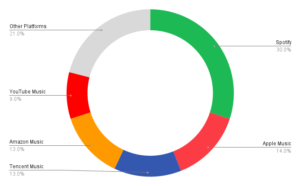The music streaming industry has witnessed remarkable growth over the past decade, with streaming services becoming the primary mode of music consumption for millions worldwide. However, with rapid expansion come concerns of potential market saturation and challenges related to subscription models. Will the streaming giants be able to find new ways to innovate and keep the industry growing? Or will we see a decline in growth and competition?
First, let’s take a look at the numbers. According to a report by Musical Pursuits, the global music streaming industry has seen a surge in subscribers, with 523.9 million subscribers in Q2 of 2021, a growth of 26.4% from the previous year. The report also states that music streaming makes up 84% of the U.S. music industry revenue.
According to a report by Statista, the number of music streaming subscribers has been increasing rapidly over the past few years and today, nearly 616.2 million people listen to their favorite artists or discover new ones via online streaming platforms. The same report also states that music streaming revenues have multiplied by more than 28 times in the last decade, surpassing sales of digital downloads and all physical music formats by a landslide. Streaming now accounts for the lion’s share of total music revenues worldwide, highlighting that the future of the industry will likely unfold on-demand and online.

However, it is difficult to predict when music streaming services will hit a saturation point that will slow growth. A report by Hypebot suggests that the opportunity for the $9.99 price point is finite and that without pricing innovation, streaming market growth will slow.
Lately, music streaming services have been raising their subscription prices to keep up with inflation and record label pressure. According to a report by DataIntelo, the global music streaming subscription service market is expected to grow at a CAGR of 13.75% in terms of revenue by 2028.
In a world where music streaming platforms once offered the mesmerizing allure of unlimited music, offline listening, and ad-free experiences for just $9.99 a month, a new chapter unfolds. Spotify, Amazon Music, and Apple Music, under the watchful eye of record labels, have quietly raised their subscription rates to $10.99 monthly. But this increase comes with a twist – it’s not about user experience, it’s about the mysterious world of artist royalties. Record labels wield their power with demands for higher subscription prices, all in the name of ensuring artists receive their fair share. However, beneath the noble façade lies a reality where artists often don’t receive the royalties they deserve.
Developed markets face the conundrum of price hikes driven by record label pressure, while a significant portion of the population has already subscribed to music streaming services. With this increase, we wonder whether population growth, smartphone saturation, and ever-changing consumer preferences will conspire to create an impending saturation showdown.
The pricing and revenue models are no longer a Rubik’s Cube with shifting colors; they’re a negotiation table where record labels demand their cut. The question remains: will the extra dollar result in fairer artist compensation or merely line the pockets of labels?
The audience still demands more than ever – ease of use, an expansive music library, and features that could rival a spaceship’s control panel. The real drama, however, unfolds behind the scenes as artists struggle to secure their fair share of the revenue pie.
As we attempt to predict the impending saturation point amidst the pricing shuffle and record label greed, we must admit it’s a bit like predicting the weather in a land where it’s sunny one minute and pouring rain the next. England anyone?
With the pricing alterations, when the revenue growth rate of streaming services starts to slow at a tortoise’s pace, we’ll know we’ve hit a saturation moment. Profits will still roll in, but companies may need to rely more on retaining existing users rather than acquiring new ones.
As the industry prepares for the approaching saturation point, it must evolve to avoid decline. Streaming platforms need to impress users with exceptional features such as high-resolution audio, enticing exclusive content, and partnerships that could put a Kardashian wedding to shame. Anything to stand out in the crowd, right?
Instead of expanding music libraries to infinity and beyond, platforms should focus on improving the quality of their recommendations and user experience. Because, clearly, we needed more algorithms telling us what to listen to.
Platforms can explore alternative revenue sources like partnering with other businesses to expand their reach and attract new users. For example, a service could partner with a mobile carrier to offer bundled subscriptions. It could partner with a music festival to offer live streaming of performances or partner with artists to sell their used guitar picks. The possibilities are endless. What could possibly go wrong?
And another thing. When smaller streaming services can’t keep up and end up in the clutches of industry giants, it’s a sure sign that we’ve reached peak saturation. Fewer choices, more monopolies – how delightful!
The music streaming industry may be booming, but there is a risk that it will become too crowded and stagnant. Will the streaming giants be able to find new ways to innovate and keep the industry growing? Or will we see a decline in growth and competition?
If all else fails, streaming services can set their sights on emerging markets where potential growth seems infinite. Expanding like a conquering empire into Latin America, Africa, and Asia will surely solve everything.
We can’t help but wonder whether the recent pricing changes will bring clarity or further complexity to the music streaming landscape. Whether $10.99 subscriptions will dominate or usher in a new era of pricing strategies, the guessing game in the music streaming industry continues. Let’s keep the music going and embrace the uncertainty as we look forward to what lies ahead in this ongoing story of market saturation, where the actual beneficiaries may not always be who they claim to be.
Maybe streaming services should just start charging by the song. That way, we can only pay for the music we actually listen to. Or maybe they could offer a subscription tier that doesn’t include any new music. That would be perfect for people who are stuck in a musical rut and only listen to the same old songs over and over again. Or maybe streaming services should take it a step further and charge us based on how many times we skip a song. I mean, if I have to skip Justin Bieber’s “Baby” for the hundredth time, they should pay me for enduring that torture!


